-
 Silver Blast Furnace Against a Gray Sky
Silver Blast Furnace Against a Gray Sky In Silver Blast Furnace, from 1954, Mildred Johnstone once again turned to the Bethlehem Steel plant for inspiration. Johnstone usually chose bright colors, but in this embroidery she used black and shades of gray, accented with red, a choice that emphasized the industrial character of her subject. As with many of her embroideries, she collaborated with the artist Joseph Cantieni, who made several preparatory sketches for this piece. (For Cantieni’s drawing search keyword “Cantieni”; for other Mildred Johnstone embroideries search keyword “Johnstone”.)
-
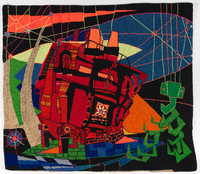 Electric Arc Furnace
Electric Arc Furnace These hangings (1977.019.001 - 1977.019.008, a part of the "Steel Series") were conceived and executed between between 1935 and 1975, when Mildred Johnstone was a resident of the Lehigh Valley. As a wife of the Vice President of Bethlehem Steel, she made frequent tours of the mills, and was inspired to record her responses in these works.
-
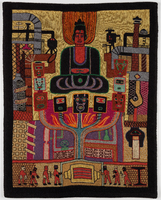 Primitive Mysteries (or Buddha in a Blast Furnace)
Primitive Mysteries (or Buddha in a Blast Furnace) These hangings (1977.019.001 - 1977.019.008, a part of the "Steel Series") were conceived and executed between between 1935 and 1975, when Mildred Johnstone was a resident of the Lehigh Valley. As a wife of the Vice President of Bethlehem Steel, she made frequent tours of the mills, and was inspired to record her responses in these works. Rectangular, with design laid out vertically. Design consists of a black "frame", abstract human figure in band at bottom, abstract industrial buildings in U-shape up left and right sides, figure of buddha flanked by U-shaped series of abstract masks. Lotus shape. 3/4 inch velcro tape mounted across top edge. Colors inlcude light brown, strong purple, and deep orange.
-
 Beach
Beach Nude woman reclining supported by her elbows, supine on a beach, a child crouches behind her to the left of the composition. The models were Jeanne Cameron Shanks, the artist's second wife, and his daughter Rene. There is a strong late afternoon light.
-
 Sunrise
Sunrise Hans Moller's painting, Sunrise, 1973, demonstrated the artist's primary concern with the formal issues of shape and color. Trained as a graphic designer in his native Germany, Moller carefully constructs his paintings out of discrete brushstrokes and color patches. His subject is reconstituted by this process into a visual impression that retains both a sense of place and mood.
-
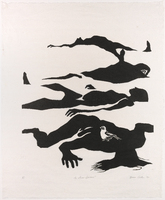 Snow Sparrow
Snow Sparrow "The massacre of several hundred Sioux Indians by the United States Army at Wounded Knee Creek, South Dakota on December 29, 1890 was the last nail, driven in the coffin lid of the American Indian. Military historians have predictably reffered to this grisly game of murdering noncombatants, as the "Battle of Wounded Knee". In truth, this needless massacre, as with countless others, including My Lai [Viet Nam, March 16, 1968], points with mockery at the mythological codes of American military discipline, and the "gentlemanly conduct" of its officers. Too long too many Americans have emulated their military heros and accepted their solutions of blind destruction of cultures and religions. Congressional medals of Honor were awarded to twenty-three American soldiers, who took part in the one sided slaughter at Wounded Knee Creek. Eighty years have passed since this display of American barbarism, and still its total, devastating effect is reflected in the subhuman condition of the American Indian today. Wounded Knee was indeed a hollow victory for Americans in the "winning of the West". The only tragedy, which surpasses the American military solution at Wounded Knee, is the cold lack of concern towards the Indians' economic and social conditions, displayed by most black and white Americans today. This prevailing attitude of indofference towards the American Indian, his wife, and children reflects a social decadence to me, and can only result in an inevitable cultural crisis in our country." [Bruce Carter, 1970] On February 28, 1973, members of the American Indian Movement (AIM) began a 71 day occupation of the hamlet of Wounded Knee, South Dakota in a dispirit attemp to draw attention to the terrible conditions on the Pine Ridge Souix Reservation. This print is # 2/15.
-
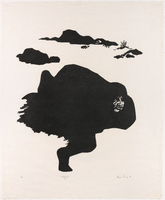 Flight
Flight "The massacre of several hundred Sioux Indians by the United States Army at Wounded Knee Creek, South Dakota on December 29, 1890 was the last nail driven in the coffin lid of the American Indian. Military historians have predictably referred to this grisly game of murdering noncombatants as the "Battle of Wounded Knee". In truth, this needless massacre, as with countless others, including My Lai [Viet Nam, March 16, 1968], points with mockery at the mythological codes of American military discipline, and the "gentlemanly conduct" of its officers. Too long too many Americans have emulated their military heros and accepted their solutions of blind destruction of cultures and religions. Congressional medals of Honor were awarded to twenty-three American soldiers, who took part in the one sided slaughter at Wounded Knee Creek. Eighty years have passed since this display of American barbarism, and still its total, devastating effect is reflected in the subhuman condition of the American Indian today. Wounded Knee was indeed a hollow victory for Americans in the "winning of the West". The only tragedy, which surpasses the American military solution at Wounded Knee, is the cold lack of concern towards the Indians' economic and social conditions, displayed by most black and white Americans today. This prevailing attitude of indifference towards the American Indian, his wife, and children reflects a social decadence to me, and can only result in an inevitable cultural crisis in our country." [Bruce Carter, 1970] On February 28, 1973, members of the American Indian Movement (AIM) began a 71 day occupation of the hamlet of Wounded Knee, South Dakota in a dispirit attempt to draw attention to the terrible conditions on the Pine Ridge Sioux Reservation. This print is # 3/20.
-
 Submission
Submission "The massacre of several hundred Sioux Indians by the United States Army at Wounded Knee Creek, South Dakota on December 29, 1890 was the last nail, driven in the coffin lid of the American Indian. Military historians have predictably reffered to this grisly game of murdering noncombatants, as the "Battle of Wounded Knee". In truth, this needless massacre, as with countless others, including My Lai [Viet Nam, March 16, 1968], points with mockery at the mythological codes of American military discipline, and the "gentlemanly conduct" of its officers. Too long too many Americans have emulated their military heros and accepted their solutions of blind destruction of cultures and religions. Congressional medals of Honor were awarded to twenty-three American soldiers, who took part in the one sided slaughter at Wounded Knee Creek. Eighty years have passed since this display of American barbarism, and still its total, devastating effect is reflected in the subhuman condition of the American Indian today. Wounded Knee was indeed a hollow victory for Americans in the "winning of the West". The only tragedy, which surpasses the American military solution at Wounded Knee, is the cold lack of concern towards the Indians' economic and social conditions, displayed by most black and white Americans today. This prevailing attitude of indofference towards the American Indian, his wife, and children reflects a social decadence to me, and can only result in an inevitable cultural crisis in our country." [Bruce Carter, 1970] On February 28, 1973, members of the American Indian Movement (AIM) began a 71 day occupation of the hamlet of Wounded Knee, South Dakota in a dispirit attemp to draw attention to the terrible conditions on the Pine Ridge Souix Reservation. This print is # 4/15.
-
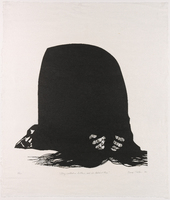 They Called Us Brothers and We Believed Them
They Called Us Brothers and We Believed Them "The massacre of several hundred Sioux Indians by the United States Army at Wounded Knee Creek, South Dakota on December 29, 1890 was the last nail, driven in the coffin lid of the American Indian. Military historians have predictably reffered to this grisly game of murdering noncombatants, as the "Battle of Wounded Knee". In truth, this needless massacre, as with countless others, including My Lai [Viet Nam, March 16, 1968], points with mockery at the mythological codes of American military discipline, and the "gentlemanly conduct" of its officers. Too long too many Americans have emulated their military heros and accepted their solutions of blind destruction of cultures and religions. Congressional medals of Honor were awarded to twenty-three American soldiers, who took part in the one sided slaughter at Wounded Knee Creek. Eighty years have passed since this display of American barbarism, and still its total, devastating effect is reflected in the subhuman condition of the American Indian today. Wounded Knee was indeed a hollow victory for Americans in the "winning of the West". The only tragedy, which surpasses the American military solution at Wounded Knee, is the cold lack of concern towards the Indians' economic and social conditions, displayed by most black and white Americans today. This prevailing attitude of indofference towards the American Indian, his wife, and children reflects a social decadence to me, and can only result in an inevitable cultural crisis in our country." [Bruce Carter, 1970] On February 28, 1973, members of the American Indian Movement (AIM) began a 71 day occupation of the hamlet of Wounded Knee, South Dakota in a dispirit attemp to draw attention to the terrible conditions on the Pine Ridge Souix Reservation. This print is numbered 4/20.
-
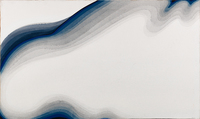 Glorification
Glorification Bold black and dark blue lines that create a wave pattern from the upper left disappearing in the upper center then reappearing in the top right corner. It also circles the left side and appears in the bottom left. Overlapping lines of increasingly lighter shades of grey move away from the darkest lines while also mirroring their shape.
-
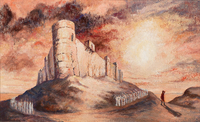 Joshua's Vision of Jericho
Joshua's Vision of Jericho Cracked stone fortress with man next to it watching the sun set behind a cloudy sky
-
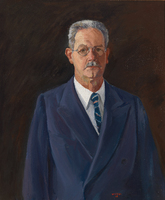 Self Portrait
Self Portrait Elderly man with mustache in blue suit with striped tie and glasses
 Silver Blast Furnace Against a Gray Sky In Silver Blast Furnace, from 1954, Mildred Johnstone once again turned to the Bethlehem Steel plant for inspiration. Johnstone usually chose bright colors, but in this embroidery she used black and shades of gray, accented with red, a choice that emphasized the industrial character of her subject. As with many of her embroideries, she collaborated with the artist Joseph Cantieni, who made several preparatory sketches for this piece. (For Cantieni’s drawing search keyword “Cantieni”; for other Mildred Johnstone embroideries search keyword “Johnstone”.)
Silver Blast Furnace Against a Gray Sky In Silver Blast Furnace, from 1954, Mildred Johnstone once again turned to the Bethlehem Steel plant for inspiration. Johnstone usually chose bright colors, but in this embroidery she used black and shades of gray, accented with red, a choice that emphasized the industrial character of her subject. As with many of her embroideries, she collaborated with the artist Joseph Cantieni, who made several preparatory sketches for this piece. (For Cantieni’s drawing search keyword “Cantieni”; for other Mildred Johnstone embroideries search keyword “Johnstone”.) Electric Arc Furnace These hangings (1977.019.001 - 1977.019.008, a part of the "Steel Series") were conceived and executed between between 1935 and 1975, when Mildred Johnstone was a resident of the Lehigh Valley. As a wife of the Vice President of Bethlehem Steel, she made frequent tours of the mills, and was inspired to record her responses in these works.
Electric Arc Furnace These hangings (1977.019.001 - 1977.019.008, a part of the "Steel Series") were conceived and executed between between 1935 and 1975, when Mildred Johnstone was a resident of the Lehigh Valley. As a wife of the Vice President of Bethlehem Steel, she made frequent tours of the mills, and was inspired to record her responses in these works. Primitive Mysteries (or Buddha in a Blast Furnace) These hangings (1977.019.001 - 1977.019.008, a part of the "Steel Series") were conceived and executed between between 1935 and 1975, when Mildred Johnstone was a resident of the Lehigh Valley. As a wife of the Vice President of Bethlehem Steel, she made frequent tours of the mills, and was inspired to record her responses in these works. Rectangular, with design laid out vertically. Design consists of a black "frame", abstract human figure in band at bottom, abstract industrial buildings in U-shape up left and right sides, figure of buddha flanked by U-shaped series of abstract masks. Lotus shape. 3/4 inch velcro tape mounted across top edge. Colors inlcude light brown, strong purple, and deep orange.
Primitive Mysteries (or Buddha in a Blast Furnace) These hangings (1977.019.001 - 1977.019.008, a part of the "Steel Series") were conceived and executed between between 1935 and 1975, when Mildred Johnstone was a resident of the Lehigh Valley. As a wife of the Vice President of Bethlehem Steel, she made frequent tours of the mills, and was inspired to record her responses in these works. Rectangular, with design laid out vertically. Design consists of a black "frame", abstract human figure in band at bottom, abstract industrial buildings in U-shape up left and right sides, figure of buddha flanked by U-shaped series of abstract masks. Lotus shape. 3/4 inch velcro tape mounted across top edge. Colors inlcude light brown, strong purple, and deep orange. Beach Nude woman reclining supported by her elbows, supine on a beach, a child crouches behind her to the left of the composition. The models were Jeanne Cameron Shanks, the artist's second wife, and his daughter Rene. There is a strong late afternoon light.
Beach Nude woman reclining supported by her elbows, supine on a beach, a child crouches behind her to the left of the composition. The models were Jeanne Cameron Shanks, the artist's second wife, and his daughter Rene. There is a strong late afternoon light. Sunrise Hans Moller's painting, Sunrise, 1973, demonstrated the artist's primary concern with the formal issues of shape and color. Trained as a graphic designer in his native Germany, Moller carefully constructs his paintings out of discrete brushstrokes and color patches. His subject is reconstituted by this process into a visual impression that retains both a sense of place and mood.
Sunrise Hans Moller's painting, Sunrise, 1973, demonstrated the artist's primary concern with the formal issues of shape and color. Trained as a graphic designer in his native Germany, Moller carefully constructs his paintings out of discrete brushstrokes and color patches. His subject is reconstituted by this process into a visual impression that retains both a sense of place and mood. Snow Sparrow "The massacre of several hundred Sioux Indians by the United States Army at Wounded Knee Creek, South Dakota on December 29, 1890 was the last nail, driven in the coffin lid of the American Indian. Military historians have predictably reffered to this grisly game of murdering noncombatants, as the "Battle of Wounded Knee". In truth, this needless massacre, as with countless others, including My Lai [Viet Nam, March 16, 1968], points with mockery at the mythological codes of American military discipline, and the "gentlemanly conduct" of its officers. Too long too many Americans have emulated their military heros and accepted their solutions of blind destruction of cultures and religions. Congressional medals of Honor were awarded to twenty-three American soldiers, who took part in the one sided slaughter at Wounded Knee Creek. Eighty years have passed since this display of American barbarism, and still its total, devastating effect is reflected in the subhuman condition of the American Indian today. Wounded Knee was indeed a hollow victory for Americans in the "winning of the West". The only tragedy, which surpasses the American military solution at Wounded Knee, is the cold lack of concern towards the Indians' economic and social conditions, displayed by most black and white Americans today. This prevailing attitude of indofference towards the American Indian, his wife, and children reflects a social decadence to me, and can only result in an inevitable cultural crisis in our country." [Bruce Carter, 1970] On February 28, 1973, members of the American Indian Movement (AIM) began a 71 day occupation of the hamlet of Wounded Knee, South Dakota in a dispirit attemp to draw attention to the terrible conditions on the Pine Ridge Souix Reservation. This print is # 2/15.
Snow Sparrow "The massacre of several hundred Sioux Indians by the United States Army at Wounded Knee Creek, South Dakota on December 29, 1890 was the last nail, driven in the coffin lid of the American Indian. Military historians have predictably reffered to this grisly game of murdering noncombatants, as the "Battle of Wounded Knee". In truth, this needless massacre, as with countless others, including My Lai [Viet Nam, March 16, 1968], points with mockery at the mythological codes of American military discipline, and the "gentlemanly conduct" of its officers. Too long too many Americans have emulated their military heros and accepted their solutions of blind destruction of cultures and religions. Congressional medals of Honor were awarded to twenty-three American soldiers, who took part in the one sided slaughter at Wounded Knee Creek. Eighty years have passed since this display of American barbarism, and still its total, devastating effect is reflected in the subhuman condition of the American Indian today. Wounded Knee was indeed a hollow victory for Americans in the "winning of the West". The only tragedy, which surpasses the American military solution at Wounded Knee, is the cold lack of concern towards the Indians' economic and social conditions, displayed by most black and white Americans today. This prevailing attitude of indofference towards the American Indian, his wife, and children reflects a social decadence to me, and can only result in an inevitable cultural crisis in our country." [Bruce Carter, 1970] On February 28, 1973, members of the American Indian Movement (AIM) began a 71 day occupation of the hamlet of Wounded Knee, South Dakota in a dispirit attemp to draw attention to the terrible conditions on the Pine Ridge Souix Reservation. This print is # 2/15. Flight "The massacre of several hundred Sioux Indians by the United States Army at Wounded Knee Creek, South Dakota on December 29, 1890 was the last nail driven in the coffin lid of the American Indian. Military historians have predictably referred to this grisly game of murdering noncombatants as the "Battle of Wounded Knee". In truth, this needless massacre, as with countless others, including My Lai [Viet Nam, March 16, 1968], points with mockery at the mythological codes of American military discipline, and the "gentlemanly conduct" of its officers. Too long too many Americans have emulated their military heros and accepted their solutions of blind destruction of cultures and religions. Congressional medals of Honor were awarded to twenty-three American soldiers, who took part in the one sided slaughter at Wounded Knee Creek. Eighty years have passed since this display of American barbarism, and still its total, devastating effect is reflected in the subhuman condition of the American Indian today. Wounded Knee was indeed a hollow victory for Americans in the "winning of the West". The only tragedy, which surpasses the American military solution at Wounded Knee, is the cold lack of concern towards the Indians' economic and social conditions, displayed by most black and white Americans today. This prevailing attitude of indifference towards the American Indian, his wife, and children reflects a social decadence to me, and can only result in an inevitable cultural crisis in our country." [Bruce Carter, 1970] On February 28, 1973, members of the American Indian Movement (AIM) began a 71 day occupation of the hamlet of Wounded Knee, South Dakota in a dispirit attempt to draw attention to the terrible conditions on the Pine Ridge Sioux Reservation. This print is # 3/20.
Flight "The massacre of several hundred Sioux Indians by the United States Army at Wounded Knee Creek, South Dakota on December 29, 1890 was the last nail driven in the coffin lid of the American Indian. Military historians have predictably referred to this grisly game of murdering noncombatants as the "Battle of Wounded Knee". In truth, this needless massacre, as with countless others, including My Lai [Viet Nam, March 16, 1968], points with mockery at the mythological codes of American military discipline, and the "gentlemanly conduct" of its officers. Too long too many Americans have emulated their military heros and accepted their solutions of blind destruction of cultures and religions. Congressional medals of Honor were awarded to twenty-three American soldiers, who took part in the one sided slaughter at Wounded Knee Creek. Eighty years have passed since this display of American barbarism, and still its total, devastating effect is reflected in the subhuman condition of the American Indian today. Wounded Knee was indeed a hollow victory for Americans in the "winning of the West". The only tragedy, which surpasses the American military solution at Wounded Knee, is the cold lack of concern towards the Indians' economic and social conditions, displayed by most black and white Americans today. This prevailing attitude of indifference towards the American Indian, his wife, and children reflects a social decadence to me, and can only result in an inevitable cultural crisis in our country." [Bruce Carter, 1970] On February 28, 1973, members of the American Indian Movement (AIM) began a 71 day occupation of the hamlet of Wounded Knee, South Dakota in a dispirit attempt to draw attention to the terrible conditions on the Pine Ridge Sioux Reservation. This print is # 3/20. Submission "The massacre of several hundred Sioux Indians by the United States Army at Wounded Knee Creek, South Dakota on December 29, 1890 was the last nail, driven in the coffin lid of the American Indian. Military historians have predictably reffered to this grisly game of murdering noncombatants, as the "Battle of Wounded Knee". In truth, this needless massacre, as with countless others, including My Lai [Viet Nam, March 16, 1968], points with mockery at the mythological codes of American military discipline, and the "gentlemanly conduct" of its officers. Too long too many Americans have emulated their military heros and accepted their solutions of blind destruction of cultures and religions. Congressional medals of Honor were awarded to twenty-three American soldiers, who took part in the one sided slaughter at Wounded Knee Creek. Eighty years have passed since this display of American barbarism, and still its total, devastating effect is reflected in the subhuman condition of the American Indian today. Wounded Knee was indeed a hollow victory for Americans in the "winning of the West". The only tragedy, which surpasses the American military solution at Wounded Knee, is the cold lack of concern towards the Indians' economic and social conditions, displayed by most black and white Americans today. This prevailing attitude of indofference towards the American Indian, his wife, and children reflects a social decadence to me, and can only result in an inevitable cultural crisis in our country." [Bruce Carter, 1970] On February 28, 1973, members of the American Indian Movement (AIM) began a 71 day occupation of the hamlet of Wounded Knee, South Dakota in a dispirit attemp to draw attention to the terrible conditions on the Pine Ridge Souix Reservation. This print is # 4/15.
Submission "The massacre of several hundred Sioux Indians by the United States Army at Wounded Knee Creek, South Dakota on December 29, 1890 was the last nail, driven in the coffin lid of the American Indian. Military historians have predictably reffered to this grisly game of murdering noncombatants, as the "Battle of Wounded Knee". In truth, this needless massacre, as with countless others, including My Lai [Viet Nam, March 16, 1968], points with mockery at the mythological codes of American military discipline, and the "gentlemanly conduct" of its officers. Too long too many Americans have emulated their military heros and accepted their solutions of blind destruction of cultures and religions. Congressional medals of Honor were awarded to twenty-three American soldiers, who took part in the one sided slaughter at Wounded Knee Creek. Eighty years have passed since this display of American barbarism, and still its total, devastating effect is reflected in the subhuman condition of the American Indian today. Wounded Knee was indeed a hollow victory for Americans in the "winning of the West". The only tragedy, which surpasses the American military solution at Wounded Knee, is the cold lack of concern towards the Indians' economic and social conditions, displayed by most black and white Americans today. This prevailing attitude of indofference towards the American Indian, his wife, and children reflects a social decadence to me, and can only result in an inevitable cultural crisis in our country." [Bruce Carter, 1970] On February 28, 1973, members of the American Indian Movement (AIM) began a 71 day occupation of the hamlet of Wounded Knee, South Dakota in a dispirit attemp to draw attention to the terrible conditions on the Pine Ridge Souix Reservation. This print is # 4/15. They Called Us Brothers and We Believed Them "The massacre of several hundred Sioux Indians by the United States Army at Wounded Knee Creek, South Dakota on December 29, 1890 was the last nail, driven in the coffin lid of the American Indian. Military historians have predictably reffered to this grisly game of murdering noncombatants, as the "Battle of Wounded Knee". In truth, this needless massacre, as with countless others, including My Lai [Viet Nam, March 16, 1968], points with mockery at the mythological codes of American military discipline, and the "gentlemanly conduct" of its officers. Too long too many Americans have emulated their military heros and accepted their solutions of blind destruction of cultures and religions. Congressional medals of Honor were awarded to twenty-three American soldiers, who took part in the one sided slaughter at Wounded Knee Creek. Eighty years have passed since this display of American barbarism, and still its total, devastating effect is reflected in the subhuman condition of the American Indian today. Wounded Knee was indeed a hollow victory for Americans in the "winning of the West". The only tragedy, which surpasses the American military solution at Wounded Knee, is the cold lack of concern towards the Indians' economic and social conditions, displayed by most black and white Americans today. This prevailing attitude of indofference towards the American Indian, his wife, and children reflects a social decadence to me, and can only result in an inevitable cultural crisis in our country." [Bruce Carter, 1970] On February 28, 1973, members of the American Indian Movement (AIM) began a 71 day occupation of the hamlet of Wounded Knee, South Dakota in a dispirit attemp to draw attention to the terrible conditions on the Pine Ridge Souix Reservation. This print is numbered 4/20.
They Called Us Brothers and We Believed Them "The massacre of several hundred Sioux Indians by the United States Army at Wounded Knee Creek, South Dakota on December 29, 1890 was the last nail, driven in the coffin lid of the American Indian. Military historians have predictably reffered to this grisly game of murdering noncombatants, as the "Battle of Wounded Knee". In truth, this needless massacre, as with countless others, including My Lai [Viet Nam, March 16, 1968], points with mockery at the mythological codes of American military discipline, and the "gentlemanly conduct" of its officers. Too long too many Americans have emulated their military heros and accepted their solutions of blind destruction of cultures and religions. Congressional medals of Honor were awarded to twenty-three American soldiers, who took part in the one sided slaughter at Wounded Knee Creek. Eighty years have passed since this display of American barbarism, and still its total, devastating effect is reflected in the subhuman condition of the American Indian today. Wounded Knee was indeed a hollow victory for Americans in the "winning of the West". The only tragedy, which surpasses the American military solution at Wounded Knee, is the cold lack of concern towards the Indians' economic and social conditions, displayed by most black and white Americans today. This prevailing attitude of indofference towards the American Indian, his wife, and children reflects a social decadence to me, and can only result in an inevitable cultural crisis in our country." [Bruce Carter, 1970] On February 28, 1973, members of the American Indian Movement (AIM) began a 71 day occupation of the hamlet of Wounded Knee, South Dakota in a dispirit attemp to draw attention to the terrible conditions on the Pine Ridge Souix Reservation. This print is numbered 4/20. Glorification Bold black and dark blue lines that create a wave pattern from the upper left disappearing in the upper center then reappearing in the top right corner. It also circles the left side and appears in the bottom left. Overlapping lines of increasingly lighter shades of grey move away from the darkest lines while also mirroring their shape.
Glorification Bold black and dark blue lines that create a wave pattern from the upper left disappearing in the upper center then reappearing in the top right corner. It also circles the left side and appears in the bottom left. Overlapping lines of increasingly lighter shades of grey move away from the darkest lines while also mirroring their shape. Joshua's Vision of Jericho Cracked stone fortress with man next to it watching the sun set behind a cloudy sky
Joshua's Vision of Jericho Cracked stone fortress with man next to it watching the sun set behind a cloudy sky Self Portrait Elderly man with mustache in blue suit with striped tie and glasses
Self Portrait Elderly man with mustache in blue suit with striped tie and glasses